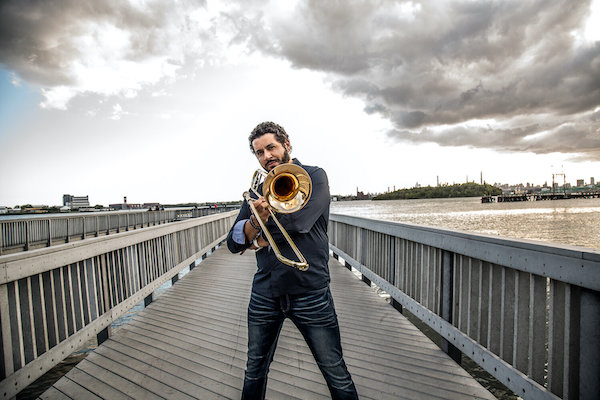Oct 28, 2025 10:47 AM
In Memoriam: Jack DeJohnette, 1942–2025
Jack DeJohnette, a bold and resourceful drummer and NEA Jazz Master who forged a unique vocabulary on the kit over his…

Trombonist Doug Beavers combines elements of r&b, salsa and jazz on his new album, Sol.
(Photo: Adrian Montañez)During the past 20 years, Doug Beavers has been, to use baseball parlance, a five-tool player. Whether navigating New York City’s modernist jazz scene or playing in Afro-Caribbean ensembles like Eddie Palmieri’s La Perfecta band and the Spanish Harlem Orchestra, Beavers, 44, has paid the rent as a master practitioner of both the soloistic and ensemble functions of the trombone. He also has pursued the arts of composing, arranging, producing and teaching.
Beavers utilizes his full toolkit on his fourth leader album, Sol, released through his label, Circle 9. Through the course of 12 originals he merges elements culled from Nuyorican salsa dura, Cuban timba and horn-heavy soul, conjuring melodic trombone lines that complement vocalists Jeremy Bosch and Carlos Cascante (and r&b singer Ada Dyer), phrased in rhythmic counterpoint to a world-class drum coro comprising trapsman Robby Ameen and hand percussionists Luisito Quintero, George Delgado and Camilo Molina. Jazz vibraphonist Joe Locke sits in on two tracks, and keyboardist Yeissonn Villamar generates textures evocative of Roy Ayers, Chic and Earth, Wind & Fire.
The album gestated in April 2019, when Beavers—whose Grammy-nominated 2017 release, Art Of The Arrangement (ArtistShare), showcased a cohort of A-list Latin jazz arrangers—was taking “a writing getaway” at his parents’ house in Sitges, a coastal town in Spain. “I was sitting on the beach, thinking, ‘It’s time to show what Doug does,’” Beavers recalled during a videoconference chat in January. “I wanted to write some songs, and to introduce the r&b element. I came up in that music through my father, who’s African-American. After high school, before I moved to New York, I played in horn bands around the Bay Area, where I grew up.
“I took my score paper, walked on the paseo along the water to a café, got a little cold beer and wrote the first bass lick of the title track. My idea was to write a record. That was the beginning.” By October, Beavers had eight compositions; in December, he recorded them.
“It was a well-run session,” Ameen said. “Doug converges all the idioms beautifully. It’s not, ‘Let’s put a little funk section here; now we’ll do this.’ He knows what he wants, and he knows what the musicians he calls will add to it. He doesn’t tell you everything about the rhythms, but he knows the nuances.”
After the December session, Beavers wrote the final four tracks, intending to record them in March and release the album in the summer. The pandemic intervened. He tried to rebook in April, but his collaborators expressed discomfort. He booked a session for May, but again was rebuffed. “I wanted continuity with the same musicians,” he said. “So, I decided to chill and work on my business plan for the label.” He finally convened his crew in early June. “The engineer had a [thermometer],” Beavers said. “In the control room and studio we wore masks—three guys were in booths, and it was just me and three horn players. On July 18, we did the last vocal session.”
Then Beavers—who studied electrical engineering before he committed to a life in music—applied his analytical skills to post-production. “I love clarity in the mix,” he said. “That’s from listening to Creed Taylor’s CTI stuff; Dave Grusin; checking out smooth-jazz like Fourplay and Earl Klugh, where the tracks are pin-drop, gorgeous mixes; and Bruce Swedien with Michael Jackson. Making sure everything is heard. A lot of ‘crack’ on bongo and congas, but also making sure the EQ is proper without being too processed.
“I love trombone, and I’m pretty good at it,” he added. “But I also love making the whole music, writing the entire palette. That gets me excited. So does the mixing—controlling the whole story of the audio. I’m still a work in progress. I feel I have so far to go.” DB

Jack DeJohnette boasted a musical resume that was as long as it was fearsome.
Oct 28, 2025 10:47 AM
Jack DeJohnette, a bold and resourceful drummer and NEA Jazz Master who forged a unique vocabulary on the kit over his…

D’Angelo achieved commercial and critical success experimenting with a fusion of jazz, funk, soul, R&B and hip-hop.
Oct 14, 2025 1:47 PM
D’Angelo, a Grammy-winning R&B and neo-soul singer, guitarist and pianist who exerted a profound influence on 21st…

Kandace Springs channeled Shirley Horn’s deliberate phrasing and sublime self-accompaniment during her set at this year’s Pittsburgh International Jazz Festival.
Sep 30, 2025 12:28 PM
Janis Burley, the Pittsburgh International Jazz Festival’s founder and artistic director, did not, as might be…

Jim McNeely’s singular body of work had a profound and lasting influence on many of today’s top jazz composers in the U.S. and in Europe.
Oct 7, 2025 3:40 PM
Pianist Jim McNeely, one of the most distinguished large ensemble jazz composers of his generation, died Sept. 26 at…

Drummond was cherished by generations of mainstream jazz listeners and bandleaders for his authoritative tonal presence, a defining quality of his style most apparent when he played his instrument unamplified.
Nov 4, 2025 11:39 AM
Ray Drummond, a first-call bassist who appeared on hundreds of albums as a sideman for some of the top names in jazz…